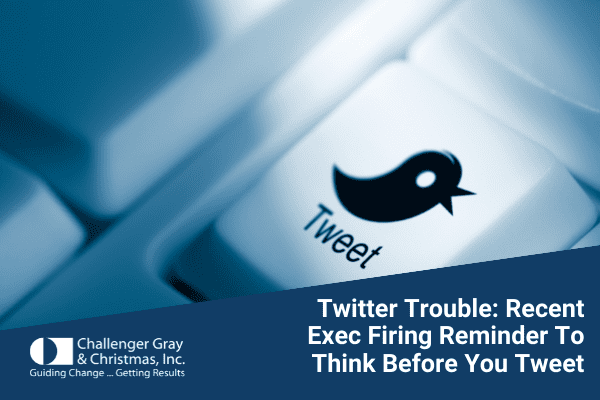
Sep 12 Twitter Trouble: Recent Exec Firing Reminder To Think Before You Tweet
Published on: Sep 12, 2013
The firing this week of Pax Dickinson, the chief technology officer of online news site Business Insider, for comments he made on Twitter, should serve as a powerful reminder that social media should be treated with great care.
“Social media sites like Twitter, LinkedIn, and Facebook are revolutionary tools that can help individuals build their own personal brand. There are many benefits to using these sites as a way to further one’s job search and/or career. However, there is a fine line between establishing an online image that can boost your professional reputation and one that can ruin it,” said John A. Challenger, chief executive officer of global outplacement consultancy Challenger, Gray & Christmas, Inc.
The fact that Dickinson’s comments were his own personal musings and in no way related to his employer or his position with the company was of little consequence once the tweets were brought to the employer’s attention. Business Insider was put in the position of either defending Dickinson or letting him go.
One could argue that Dickinson’s tweets were taken out of context. However, that is the primary problem with social media; 140 characters does not really allow for context. Besides lacking context, posts on Twitter, Facebook or LinkedIn do not lend themselves to nuanced communication or interpretation, such as satire, parody, sarcasm or irony. A handful of one’s closest friends and followers might get the joke, but the majority is likely to misinterpret the intended meaning.
“So, why take the chance? If Twitter serves as some type of cathartic outlet, then post under a pseudonym or as your alter-ego. Otherwise, refrain from posting anything you would not say in front of a job interviewer, board of directors or religious leader,” said Challenger.
The wrong tweet can not only get you fired, but it can also prevent you from finding a new job. A recent survey by CareerBuilder.com found that 43 percent of hiring managers who research job seekers via social media found information that caused them to eliminate a candidate from consideration. Half of the respondents indicated it was an inappropriate photo or statement that sealed the candidate’s fate.
Challenger provided the following guidelines when it comes to managing one’s social media presence for the purposes of job search and/or career advancement:
1. Remember The Goal
All of your social media activity boils down to one objective, which is to pave the way for a face-to-face introduction. Keep your eyes on the prize as you have fun making new virtual connections.
2. Post Regularly
Post or tweet no less than once a week, and no more than three times a day. Social media sites will send you an update once a week or once a day; you can use that email as a reminder to log in and tweet, post, or contribute to a group discussion. Alternatively, set up a calendar reminder for yourself.
3. Personalize Requests
When possible, always send a personal note along with a connection request. Refrain from using stock messages such as, “I’d like to add you to my professional network on LinkedIn”.
When requesting an introduction, write a note to your mutual connection and then a separate note to the person you want to meet. In both cases, draft a compelling subject line and a short introduction that explains why you hope to connect.
4. Be Tactful in Follow-Up
There is no guarantee that everyone you want to connect with will want to connect with you. If you haven’t heard from a potential connection, send a reminder note 10 days after the initial request. If that doesn’t work, it’s best to move on to people who are more interested or responsive.
5. Interact Often
Consider congratulating your connections on accomplishments or commenting on articles they post. Contributing positively to your connections’ activity encourages them to do the same for you.
6. Be Professional
Use an appropriate picture for your profile (no pets, quirky backgrounds or funny expressions).
Your profile information should reflect the content of your cover letter and/or resume. The writing can be a little less formal, but proper grammar, spelling and proofreading are essential. Refrain from using abbreviations or emoticons.
Be totally truthful and never stretch the facts — remember that your profile is public.
7. Be Responsive
While logging in to each account daily is ideal, what’s most important is that you maintain a consistent presence and respond to messages, connection requests, and tweets in a timely fashion.
8. Be Diplomatic
Never be too direct. Asking your contacts for a job flat-out is neither polite nor appropriate. Instead, request an in-person courtesy or informational interview, after you’ve established an online relationship.
9. Join Groups
The number of groups you belong to on LinkedIn and Facebook should reflect the number of professional affiliations you have (or want to have) in real life. For instance, if you attended college, were an accounting major and love social media, it would be great to join your alumni group, an accounting group or two and a social media group or two.
To get the most benefit from group participation, quality trumps quantity.
